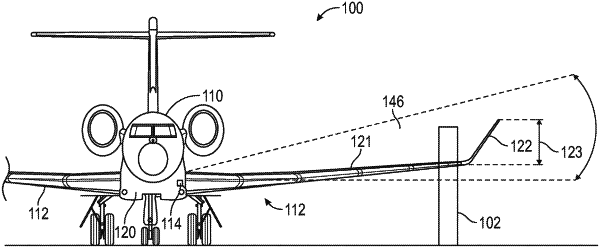| CPC G01S 17/933 (2013.01) [B64D 43/00 (2013.01); B64D 45/00 (2013.01); B64D 47/02 (2013.01); G01S 17/08 (2013.01); G08G 5/04 (2013.01)] | 20 Claims |

|
1. An aircraft, comprising:
a fuselage;
a flight deck;
a main wing coupled with and extending outward from the fuselage; and
a collision avoidance system coupled with the fuselage adjacent the main wing, the collision avoidance system comprising:
a first laser rangefinder configured to generate a first laser beam in a first direction laterally outward of the fuselage;
a second laser rangefinder configured to generate a second laser beam in a second direction laterally outward and farther away from the main wing relative to the first direction;
a first diverging lens optically coupled with the first laser rangefinder to spread the first laser beam in a vertical dimension;
a second diverging lens optically coupled with the second laser rangefinder to spread the second laser beam in a vertical dimension, wherein beam spreading characteristics of the first diverging lens are different than beam spreading characteristics of the second diverging lens to account for the first and second directions, and wherein the second diverging lens spreads the second laser beam less as the second angle departs from perpendicular to a longitudinal axis of the aircraft; and
a detection circuit coupled with the first laser rangefinder and the second laser rangefinder to:
detect an object within a collision risk zone adjacent to the main wing based on input from at least one of the first laser rangefinder and the second laser rangefinder; and
generate an alert that the object is at risk of colliding with the main wing.
|